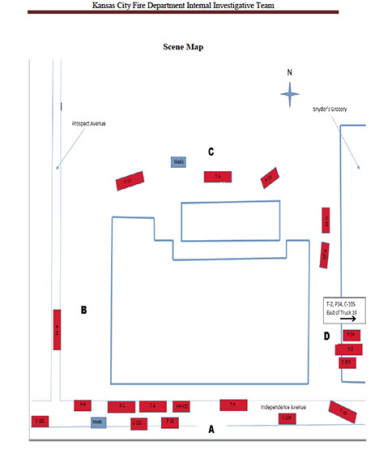By Paul Thompson
Northeast News
May 25, 2016
KANSAS CITY, Missouri – A 71-page report released by the Kansas City Fire Department on the evening of Tuesday, May 24 includes 14 recommendations aimed to prevent further tragedies at the scenes of dangerous structure fires.
KCFD firefighters John Mesh and Larry Leggio were killed on October 12, 2015 when a brick structure collapsed on them while they were fighting a raging arson fire on Independence Avenue.
Below are some of the more important details included in the extensive report, which covers from the time of the dispatch call until the brick wall collapsed:
*Take note – all page numbers listed below are for the full 71-page internal investigation report released by KCFD. All 14 recommendations are listed at the bottom of this story.
– The internal investigation team consisted of 11 members: Assistant Chief of Department Jeff Grote, Union Local 42 Designee Captain Gary Reese, Union Local 3808 Designee Battalion Chief James Walker, Deputy Chief Todd Ackerson, Deputy Chief Vincent Boucher, Deputy Chief Jeff Johnson, Battalion Chief Damon Barkley, Battalion Chief Peter Knudsen, Battalion Chief Brian Trickey, Union Local 42 Business Agent Justin Abraham, and Recorder of Record Sheryll Wilson. (Page 8)
-KCFD companies Truck 2, Truck 5, Truck 6, Truck 12, Rescue 9, Pumper 23, Pumper 24, Pumper 27, Pumper 35, and the KCFD Communications Center and Command Staff all provided factual information and eyewitness testimony for the purposes of the report. (page 10)
-The report describes a January 29, 2016 meeting with ATF officials, which led KCFD investigators to the conclusion that the fire was very likely started in the “worst possible location for civilian, firefighter, and building survivability.” The building, erected in 1925, didn’t have a sprinkler system or a centrally monitored fire alarm system. (page 17)
–A masonry brick wall will fall straight downward when it collapses, forming a pile of rubble at the base of the wall. The report says that this type of collapse closely resembles a curtain drop. In these instances, the Collapse Zone can be smaller than normal, although it’s still hazardous for firefighters to remain in the area. (page 21)
-A number of company officers on the scene stated in the after-action review that they were surprised by how much the fire had advanced by the time they arrived on the scene. The report notes that this information is critical, because it shows that the fire had “advanced past the incipient stage well before the original dispatch or 911 call.” Furthermore, the report states that the KCFD had previously pre-planned the structure, determining that in many cases, it would be best to focus a fire attack on the C-side of the structure. When the first KCFD unit arrived at 7:29 p.m., they did indeed begin fire attack on the C-side. (page 23)
-Three different individuals held Incident Command during the incident. While basic tenets of the department dictate that transfer of command should be face-to-face, the report found that face-to-face transfer did not occur during the first command transfer. (page 23)
–The ranking officer verbally ordered that firefighters evacuate the D-side alley just moments before the wall collapsed at 8:06 p.m. According to the radio log, aerial master stream operations from the C-side of the building were ongoing from 7:57:40 p.m. to 8:02:26 p.m. The report acknowledges that applied water can add weight to a structure, though it’s still unknown if the water was a contributing factor to the wall’s eventual collapse. (Page 24)
–Crucially, the after action review indicated that a number of the companies operating at the scene did not hear the “Collapse Zone Order” issued by command. (Page 24)
-The tactical decision to put resources within the collapse zone was issued by radio by the division chief officer, following a conversation with a FAO (fire apparatus operator) on the structure’s D-side. The message wasn’t confirmed by the Incident Commander. Firefighters were tasked with placing a water stream into a pair of openings where the fire was especially strong. (Page 25)
–The report found that after firefighters were removed from the structure, there was an increased sense of safety. In part due to that sense, operations continued in the alley on the structures’ D-side. The alley was also used as a “primary avenue of travel” until the wall collapsed. It further found that proper consideration of the potential collapse of the D-side wall wasn’t recognized by many of the firefighters at the scene. (Page 26)
–a TeleStaff report showed that crew fatigue did not play a significant role in the tragic nature of the incident. Run volume on the date of the incident for the companies who played a major role at the scene is as follows: Pumper 10 responded to 12 calls; Truck 3 responded to four; Truck 2 responded to three; P23 responded to seven, Truck 10 responded to 3, and Car 104 responded to three. (pages 26 and 27)
–After the collapse, all ground operations were shifted by the communications center from tactical channel 5 to tactical channel 6 to avoid competing for air time with officers in trouble. However, on-scene personnel and the Incident Commander did not switch to tactical channel 6, causing confusion and a lack of communication when the May-Day companies arrived on scene. (page 27)
–Personnel on the structure’s D-side were operating outside of the collapse zone until minutes before the wall collapsed. They moved inside the collapse zone when the fire grew more aggressive, impinging upon a KCFD fire apparatus that had previously been blocked from movement by a utility vehicle. (page 28)
–The report noted the effect the KCFD culture may have had on the tragedy. It states that suppression tactics in the D-side alley might have driven decision-making, as opposed to objectives and strategy. It further notes that “When there is little to save, we should risk very little.” (Page 30)
REPORT RECOMMENDATIONS:

#1. The department should develop a Collapse Zone policy. The KCFD does not have a specific policy for Collapse Zones. The recommendation suggests that collapse zones should have visual identification markers such as lighted beacons or incident scene tape.
#2. The department should update current communication policies as they apply to emergency incidents. The investigate team found a need to create departmental procedures whereby firefighters provide confirmation of critical emergency incident communications.
#3. The department should develop an inclusive training program that revolves around the merits of Situational Awareness. A system should be created and implemented that establishes clear rules of engagement and initial scene size-up. Also, the risk-versus-reward methodology should always be employed.
#4. The department’s current Incident Management System Manual needs to be updated to include current practices and new standards. That includes having a dedicated safety officer on all incidents, development of a survivability profile, and the creation of major incident benchmarks, among others.
#5. Train all department officers regarding Safety Officer duties and responsibilities.
#6. Train all emergency personnel in building construction. This includes recognition of critical structural weaknesses, as well as training on signs of collapse.
#7. Ensure that all personnel properly wear all assigned Personal Protective Equipment when required by policy.
#8. Develop, train, and employ an Incident Accountability System for use in all emergency incidents. The department’s general operating guideline is currently impractical, outdated, and inefficient for emergency scene use.
#9. The fire department should consider preparing, training, and implementing new policies and procedures in a different format. This recommendation includes implementation of an annual review of all policies and procedures.
#10. The department should develop a policy that addresses the formation of an investigation team concept to be employed in any serious injury incidents.
#11. The department should develop and implement a behavioral health training, referral and educational program that also addresses peer counseling, suicide prevention and intervention. Although not considered a contributing factor in the deadly fire, the department feels it’s important to ensure emotional health and recuperation of all members of the KCFD.
#12. The department should review the current May-Day General Operating Guidelines and update to include new communication considerations. Internal investigators identified possible confusion in the May-Day policy guidelines, and recommended a review of the policy that would include a regional perspective.
#13. The department should further develop leadership and foster management capabilities as part of an Officer Development program.
#14. The Department should enhance its current building data collection methods utilized by emergency operations and integrate high hazard risk identification with Fire Prevention records. The investigators noted here that pre-fire tactical planning should be a priority on all areas of the city, with inspection records interchangeable and available for all divisions.
Additional Note: A detailed Incident Timeline of the deadly fire can be found from pages 45-65 of the complete KCFD report.


















